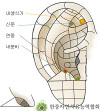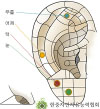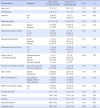Abstract
Purpose
The purpose of this study was to determine the effects of auricular acupressure on menstrual pain, dysmenorrhea and academic stress among college students.
Methods
A non-equivalent pretest-posttest design was used. Participants were 57 female students recruited from one college. The treatment group (n=30) received an auricular acupressure on a valid zone and the control group (n=27) received an auricular acupressure on an invalid zone (placebo). The independent t-test and χ2-test were used to examine group differences by using SPSS/Win18.0.
Results
Subjects in the treatment group reported much less menstrual pain of premenstrual day (p=.001), 1st day (p<.001), 2nd day (p=.003), and dysmenorrhea (p=.003). Of significance, participants in the treatment group reported much less academic stress (p=.049) following auricular acupressure.
Conclusion
The findings support that auricular acupressure is effective in controlling menstrual pain and academic stress related to menstruation. As the method is simple it would be useful for women students to be taught and encouraged to utilize this method to mitigate the symptoms related to menstruation through self care.
Figures and Tables
References
1. Campbell MA, McGrath PJ. Use of medication by adolescents for the management of menstrual discomfort. Arch Pediatr Adolesc Med. 1997; 151:905–913. DOI: 10.1001/archpedi.1997.02170460043007.

2. Cha NH. The effects of auricular acupressure therapy on abdominal pain and dysmenorrhea in female university students. J Korean Acad Community Health Nurs. 2008; 19(2):280–289.
3. Chang SB, Jun EM. Effects of SP-6 acupressure on dysmenorrhea, cortisol, epinephrine and norepinephrine in the college students. J Korean Acad Nurs. 2003; 33:1038–1046.

4. Choi JD. Correlation between medicine and culture by illumination on the placebo effect. Philos Med. 2006; 2:19–34.
5. Chon KK, Kim KH, Yi J. Development of the revised life stress scale for college students. Korean J Health Psychol. 2000; 5:316–335.
6. Dawood MY. Primary dysmenorrhea: Advances in pathogenesis and management. Obstet Gynecol. 2006; 108:428–441.
7. Fassoulaki A, Paraskeva A, Patris A, Pourgiezi T, Kostopanagiotou G. Pressure applied on the extra 1 acupuncture point reduces bispectral index values and stress in volunteers. Anesth Analg. 2003; 96:885–890. DOI: 10.1213/01.ANE.0000048713.41657.D3.

8. Han SH, Hur MH, Buckle J, Choi J, Lee MS. Effect of aromatherapy on symptoms of dysmenorrheal in college students: A randomized place-controlled clinical trial. J Altern Complement Med. 2006; 12:535–541.
9. Harel Z. A contemporary approach to dysmenorrhea in adolescents. Paediatr Drugs. 2002; 4:797–805.

10. Hsu DT. Acupuncture. A review. Reg Anesth. 1996; 21:361–370.
11. Jun EM. Effects of SP-6 acupressure on dysmenorrhea in female university students. Seoul: Yonsei University;2003. Unpublished doctoral dissertation.
12. Jung HS. A study on strategies to improve health management for female students. Seoul: Korean Women's Development Institute;2005.
13. Kang HJ. Effect of yoga exercise program on dysmenorrhea, menstrual pain and vasopressin of the female university students. Educ Rev. 2009; 20:1–19.
14. Kim HD. Seed Health depending on bodily constitution. Seoul: Chung San;1996.
15. Kim JE. Comprehensive understanding of perimenstrual discomfort: A Triangulation of methods and perspectives. Seoul: Seoul University;1995. Unpublished doctoral dissertation.
16. Kim KB. The Effect of Auricular Acupressure Therapy on Anxiety of Cancer Patient. J Korean Acad Nurs. 2002; 32:888–896.
17. Kim SY, Lee HY. Effect of the auricular acupressure therapy on dysmenorrhea of puberty girls. Korean J Women Health Nurs. 2010; 16:20–28.

18. Kim YH, Cho SH. The effect of foot reflexology on premenstrual syndrome and dysmenorrhea in female college students. Korean J Women Health Nurs. 2002; 8:212–221.

19. Korea Statistical Information Service. Statistical report of the disease. 2010. Retrieved July 4, 2012. from http://www.kosis.kr.
20. Lee HY, Hale CA, Hemingway B, Woolrige MW. Tai Chi exercise and auricular acupressure for people with rheumatoid arthritis: an evaluation study. J Clin Nurs. 2012; 21:2812–2822. DOI: 10.1111/j.1365-2702.2011.04058.x.

21. Maa SH, Tsou TS, Wang KY, Wang CH, Lin HC, Huang YH. Self administered acupressure reduces the symptoms that limit daily activities in bronchiectasis patients: Pilot study findings. J Clin Nurs. 2007; 16:794–804. DOI: 10.1111/j.1365-2702.2005.01515.x.
22. Moos RH. The development of a menstrual distress questionnaire. Psychosom Med. 1968; 30:853–867.

23. Johnson JE, Rice VH. Sensory and distress components of pain: implications for the study of clinical pain. Nurs Res. 1974; 23:203–209.
24. Oleson T. Auriculotherapy Manual. 3rd ed. Tottenham: Churchill Livingstone;2003.
25. Schuler RS. Definition and conceptualization of stress in organizations. Organ Behav Human Perform. 1980; 25:184–215.

26. Shin HS, Song YA, Seo S. Effect of Nei-Guan point (P6) acupressure on ketonuria levels, nausea and vomiting in women with hyperemesis gravidarum. J Adv Nurs. 2007; 59(5):510–519.

27. Sok SH. The effect of auricular acupuncture pressure therapy on insomnia of elderly people. Seoul: Kyung Hee University;2001. Unpublished doctoral dissertation.
28. Wang MC, Hsu M, Chien L, Kao C, Liu C. Effects of auricular acupressure on menstrual symptoms and nitric oxide for women with primary dysmenorrhea. J Altern Complement Med. 2009; 15:235–242. DOI: 10.1089/acm.2008.0164.

29. Woods NF. Relationship of socialization and stress to perimenstrual symptoms, disability, and menstrual attitudes. Nurs Res. 1985; 34:145–149.

30. Wu RD, Zhang HD, Lin LF. Observation on ear point taping and pressing therapy for treatment of primary dysmenorrhea. Zhongguo Zhen Jiu. 2007; 27(11):815–817.




 PDF
PDF ePub
ePub Citation
Citation Print
Print







 XML Download
XML Download